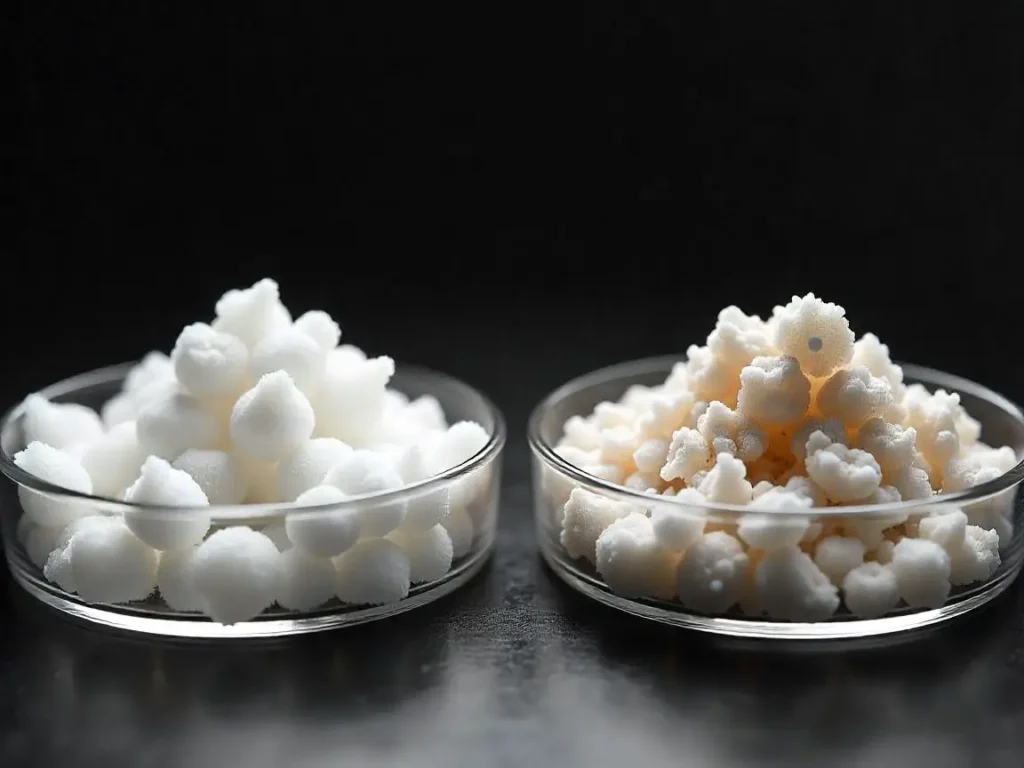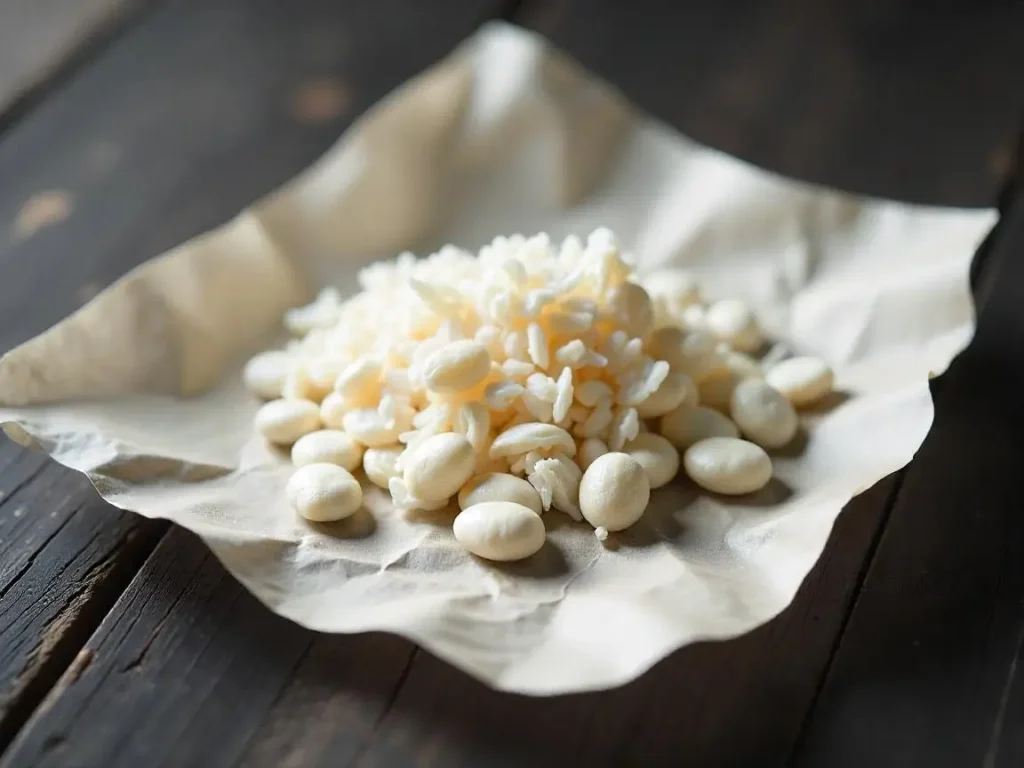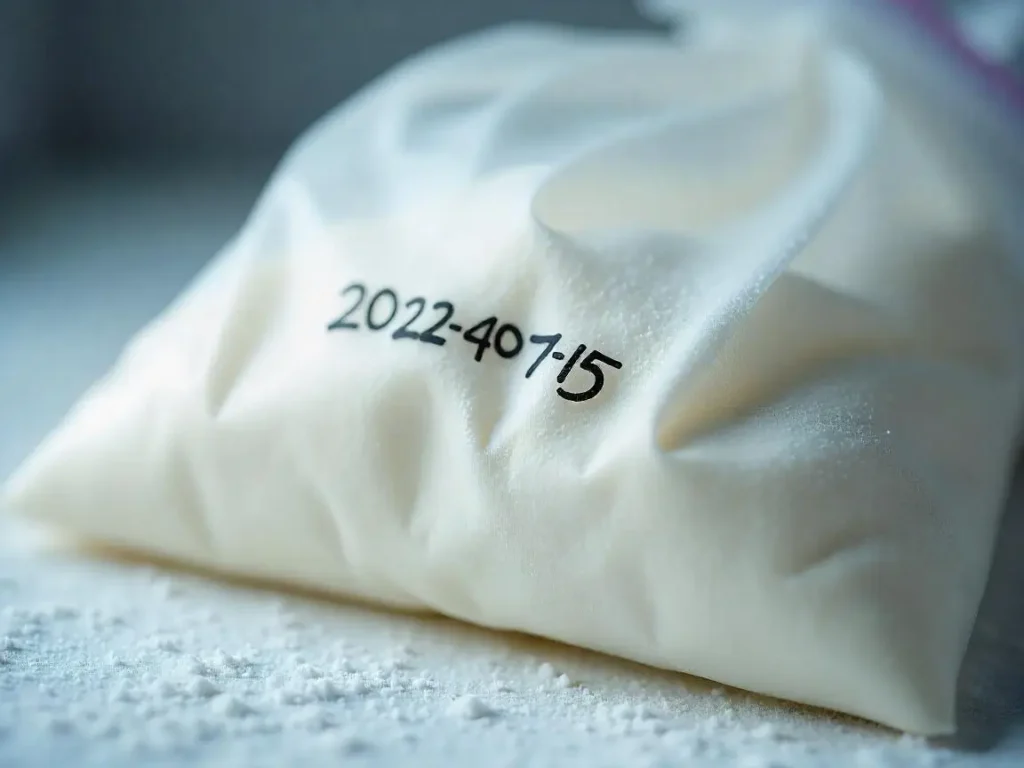Storing your milk kefir grains properly is essential for maintaining these living cultures and ensuring they remain viable for future batches. When you need a break from making kefir daily, creating a favorable environment for your grains allows them to sustain their beneficial properties while dormant. With the right precautions, your kefir grains can maintain their health for weeks or even months, ready to restart your fermentation journey whenever you’re ready.
To store kefir grains for short periods (1-2 weeks), place them in fresh milk and refrigerate them in a clean jar with a loose lid. This slows down fermentation while keeping the culture alive. For longer storage, you can dehydrate or freeze your grains following specific methods that preserve their microbial balance. I’ve found through years of working with kefir that using filtered water for rinsing and clean utensils for handling prevents contamination and keeps your grains thriving, allowing you to enjoy their digestive benefits for years to come.
In this article, we cover everything about storing kefir grains properly, including short and long-term storage methods, troubleshooting common problems, best practices to maintain grain viability, and expert tips to ensure your kefir grains remain healthy and productive.
Table of Contents
Understanding Kefir and Its Shelf Life
Kefir, a tangy fermented drink loved for its health benefits, starts with tiny living treasures called kefir grains. These aren’t actual grains like wheat or rice, they’re squishy, cauliflower-like colonies of beneficial bacteria and yeasts that transform ordinary milk into a gut-friendly beverage. There’s also water kefir grains, which look like translucent crystals and work with sweetened water instead of dairy. Both types create drinks rich in probiotics that support digestive health, but they need proper care to thrive.

The shelf life of kefir depends on how it’s stored and various environmental conditions. In my experience making kefir for over five years, properly maintained grains can last indefinitely when fed regularly. The type of kefir grains you have matters too, milk kefir grains typically need feeding every 24-48 hours at room temperature, while water kefir grains often ferment faster. Temperature plays a huge role: too warm (above 85°F) and they’ll ferment too quickly; too cold and they become sluggish. I’ve found that clean equipment, consistent feeding schedules, and proper storage are the golden rules for keeping these beneficial bacteria communities happy and productive for years.
Short-term Storage of Kefir Grains
When you need a break from regular fermentation, storing your grains properly ensures they stay healthy during the pause. For milk kefir grains that aren’t actively culturing, refrigeration of kefir grains is the best short term solution. Simply add your milk kefir grains to a small amount of milk (about 2-4 cups fresh milk) in a clean container with a tight lid. This method keeps the grains safe and healthy for up to 3 weeks in your refrigerator.
For longer breaks, remember to keep your grains well fed by changing the milk weekly to prevent excess kefir milk from building up and making the grains too acidic. When you’re ready to resume, your grains might seem sluggish at first, but after 2-3 fermentation cycles, they’ll return to full health. Water kefir grains follow similar principles but should be stored in sugar water instead of milk, with refreshing of the solution needed more frequently to maintain their vitality during short term storage of 3 to 4 weeks.
Long-term Storage Methods
Store kefir grains for extended periods using several reliable methods. When you need long-term storage options, consider freezing or dehydrating your precious cultures. Dehydrated form preservation works particularly well when you won’t be making kefir for months, while refrigeration of kefir grains suits short-term breaks of a few weeks. For milk kefir grains, place them in a small amount of milk within a sealed container before refrigerating, changing the milk weekly to keep them healthy. Water kefir grains prefer sugar water for storage, creating a refreshing environment that maintains their vitality. Remember that sugar water needs changing more frequently than milk.

Freezing kefir grains provides excellent long-term storage when you need a break from making kefir. To prepare grains for freezing, start by rinsing them in non-chlorinated water before patting dry with a clean towel. Place them in a freezer-safe bag with a little milk powder or sugar depending on the grain type. Don’t forget to label your container with the date and type of grains. The freezer keeps them dormant but viable for up to six months. When ready to use them again, thaw gradually in the refrigerator before introducing them to fresh milk or sugar water, understanding that they may need several feeding cycles before returning to full strength.
How to Store Kefir Grains During a Break?
Taking occasional breaks from drinking kefir is sometimes necessary, whether due to a vacation, holiday season, or following a special diet. During these times, properly storing your kefir grains ensures this live culture remains viable until you resume your daily routine of kefir making.
When preparing for a short break (1-2 weeks), simply put the grains in fresh milk and place them in your refrigerator. The cold temperature slows down fermentation while allowing the grains to stay alive. For longer absences, consider placing them in filtered water with a bit of sugar or dried milk powder to provide minimal food without causing over-fermentation. Remember that these resilient cultures need ongoing care – even during storage – to maintain their vitality and fermentation abilities when you’re ready to enjoy their benefits again.
Slowing Down Kefir Grains
If you want to slow down your kefir grains, the easiest way is to use cold temperatures. When you store grains in the refrigerator, their culturing process becomes much slower. This is perfect if you need a break or want to make less kefir for a while. In my own kitchen, I often keep my grains in the fridge when I travel or just want to make smaller batches. This simple tutorial is great for anyone who wants to reduce the fermentation frequency without stopping the grains from being active.

By using the fridge, you don’t have to pause the grains completely-you just slow down their activity. This method is ideal if you want to keep your grains healthy but don’t need daily kefir. Just remember to change the milk every week or so to keep the grains happy and ready to use when you want to start regular culturing again.
How to Keep Kefir Grains Safe When Taking a Break?
When you need to take a break from drinking kefir-maybe for a vacation, a special diet, or just a change in your daily routine-it’s important to store kefir grains the right way. From my experience, the best way to care for these live culture grains is to put the grains in a clean jar, cover them with fresh milk (their favorite food), and place them in the fridge. This slows them down so they stay alive but don’t ferment too quickly. During the holiday season or other breaks, this method has always worked for me, keeping my grains healthy until I’m ready to start preparing kefir again.
If the break is longer, it’s necessary to change the milk every week or so to keep the grains fresh. When you return, simply take them out, add new milk, and let them warm up to room temperature. I always check on my grains and give them a couple of batches to fully “wake up” before drinking kefir again. This way, your grains will be ready and strong, just like before your break.
How to Store Kefir Grains for Long Breaks?
When I need to take a long break from making kefir, I always use the drying method to keep my kefir grains safe for up to 6 months. First, I gently rinse the grains with filtered water to remove any milk. Then, I lay them out on unbleached parchment paper in a safe location where they can dry at room temperature for about 3 to 5 days. If the humidity is high or I want to speed things up, I sometimes use a dehydrator set to a heated setting, but never above 85°F to avoid damaging the grains.
Once my dried milk kefir grains are ready, I store them in an air-tight bag with a little powdered milk and place it in the refrigerator. This keeps them fresh for up to 6 months. When I want to use them again, I simply rehydrate and revive the grains by soaking them in milk, and they come back to life, ready to make delicious kefir once more.
Best Ways to Store Kefir Grains
Storing milk kefir grains well helps them stay in good shape and produce tasty kefir with little waste. For short-term fridge storage (up to 7–14 days), place your grains in a clean glass jar and cover with milk. Use more milk than usual, about double so the grains have enough food. Pause activity by keeping the jar at cold temperatures (around 4 °C). Leave the top lid slightly open for airflow, and change the milk every week or when it becomes very sour. This method is simple and avoids complicated procedures, but you must remember to refresh the milk on time.
For longer periods (up to 2 months), switch to a sugary solution: in a smaller jar, dissolve two of sugar (two tablespoons) in fresh non-chlorinated water and add your water kefir grains or milk kefir grains. Stir until fully dissolved, then store in the fridge with the lid pause activity. This slows the grains’ metabolism and keeps them alive with minimal waste. When you’re ready to use them again, simply strain, rinse with non-chlorinated water, and transfer back to milk.

If you need very long-term storage (up to 6 months), consider drying kefir grains or freezing kefir grains. For drying, rinse grains in fresh non-chlorinated water, place on parchment paper or a paper towel, and let them dry for a few days, turning around for consistent drying until completely dry. Store dried grains in a plastic zip bag with a pinch of powdered milk. To freeze, rinse and pat grains dry, then place in a plastic jar or plastic bag with powdered milk for protection, and freeze. Both methods minimize complicated procedures but may reduce viability, so test reactivation on a small batch first.
Keeping Your Kefir Fresh: Storage Secrets Revealed
My grandma introduced me to kefir years ago, and this popular fermented drink changed my digestion forever! The key to enjoying its full health benefits lies in understanding proper storage techniques. I’ve learned that when you store kefir correctly, you preserve its powerful probiotic content that supports gut health. For the best flavor and nutritional value, I always use glass storage containers with tight lids. Plastic can affect the taste. I keep my homemade batch in the fridge door where temperature stays consistent, not too cold. This simple approach has dramatically extended the shelf life of my daily kefir, maintaining its tangy goodness and longevity. Through years of brewing, I’ve discovered that giving the container a gentle shake before serving helps distribute the beneficial cultures that might settle at the bottom, ensuring every sip delivers maximum freshness.

To keep your kefir grains active and healthy while stored, feed them fresh milk every 24 hours at room temperature. When I need a break from making kefir, I place my grains in a small jar with fresh milk in the refrigerator, which slows fermentation but maintains viability. Every two weeks during dormant storage, I refresh this milk to prevent the grains from starving. Before my vacation last summer, I tried freezing some grains in milk as backup. They recovered beautifully after thawing gradually in the fridge! The most important lesson from my decade of kefir brewing: healthy grains produce better health benefits, so these simple techniques for storage actually create a more potent drink.
Containers for Kefir Storage and Techniques for Extending Shelf Life
When storing your kefir grains, choosing the right container and handling technique makes all the difference. Glass containers and glass jars are often considered ideal because they’re non-reactive with the acidic nature of kefir. They allow you to easily monitor the condition of your grains while preventing chemical leaching. My grandmother always used a small mason jar with excellent results! Just ensure you seal tightly to prevent air exposure and potential contamination.
If glass seems too fragile for your needs, BPA-free, food-grade plastic containers offer a lightweight, convenient alternative. However, plastic can absorb odours, develop stains and scratches that might harbour bacteria over time. For long-term preservation, consider freezing kefir grains in a freezer-safe container, leaving enough space for expansion. This extends shelf life up to three months without significantly compromising probiotic benefits. When ready to use, thaw the frozen kefir in your refrigerator, then gently stir before consuming. Always practice proper handling with clean utensils – avoid metal spoons as metals react with the acids in kefir. Instead, use plastic utensils or wooden utensils to maintain purity and prevent harmful bacteria.
How to Keep Your Kefir Grains Healthy and Fresh?
When making fresh kefir at home, knowing the signs of spoilage is crucial for both safety and taste. Your kefir grains should produce a pleasantly tangy, slightly tart taste with a mild yeasty smell. If you notice a strong, unpleasant odour or an overly sour or unusual flavour, this indicates your kefir has likely spoiled. Always check the surface of your container for any visible mould, if present, the entire batch must be discarded. Healthy kefir should be somewhat thick but not excessively slimy, and while it naturally separates into chunks during fermentation, extreme separation can signal problems.

To ensure longevity and quality of your grains, follow these preventative measures: maintain strict cleanliness with all clean utensils and containers to prevent harmful bacteria; keep finished kefir refrigerated and avoid leaving out for prolonged periods; use airtight containers to minimize air exposure; prepare small batch quantities to consume within a week while still fresh; avoid metal utensils as the acids in kefir can react with metals affecting taste or releasing unwanted substances – instead, use plastic utensils, wooden utensils, or glass utensils; and practice regular monitoring of your kefir grains and implement good hygiene practices to reduce risk of waste. I’ve found that consistent daily checking has helped me catch potential issues early, preserving my grains for years without major problems.
Adjusting Kefir Batch Size After Storage Break
When bringing kefir grains back to life after storage, I’ve found that a gentle approach works best for adjusting your batch size. Start small-typically half your normal amount of milk for the first fermentation. My kefir grains were once left in the fridge for three weeks, and when I tried to make a full batch immediately, they struggled to ferment properly. The grains need time to wake up and rebuild their microbial strength after being dormant. Monitor this first batch closely; it might ferment slower than usual and produce a thinner kefir, but this is perfectly normal as the bacteria and yeasts reactivate.

For your second and third batches, you can gradually scale up or down depending on your needs. If scaling up, add about 25% more milk with each new batch until you reach your desired quantity. When reducing batch size, use fewer grains rather than crowding a small amount of milk with too many hungry grains. From my experience working with kefir for over five years, post-storage grains typically need 2-3 fermentation cycles to return to full strength. The perfect balance comes when your kefir consistently ferments within your preferred timeframe (usually 24 hours) and reaches your desired thickness and tanginess. Just remember that patience during this transition period rewards you with healthier grains and better kefir in the long run.
Other Ways to Make Kefir
If caring for kefir grains feels overwhelming, don’t worry there are simpler options. Powdered kefir starter (also called direct-set culture) offers convenience for those who can’t make kefir on a daily basis. I’ve found these starter cultures work beautifully when life gets hectic. Simply empty a packet into milk, follow package instructions, and enjoy. The downside? Unlike traditional grains that can be used indefinitely, each powdered starter typically makes just one batch. While some brands claim you can re-culture several times, the bacteria weakens with each use. I’ve tried re-culturing commercial starters about 3-4 times before noticing flavor changes, definitely an alternative approach if you’re traveling or taking breaks from your regular routine. Just remember that nothing quite matches the depth of flavor and probiotic diversity that comes from learning to properly care for kefir grains.
Conclusion
Storing kefir grains properly allows them to remain viable for years. Whether refrigerating in fresh milk for short breaks or freeze-drying for longer storage, these living cultures need special attention to maintain their health. Through my years making kefir, I’ve found that changing the storage milk weekly, using glass containers, and keeping grains at appropriate temperatures helps preserve their unique probiotic benefits. While powdered starters offer convenience, nothing matches the depth of flavor from traditional grains. Remember to check your grains regularly for signs of health – they should produce pleasantly tangy kefir with a mild yeasty smell. With proper care and these simple storage techniques, you’ll enjoy the digestive benefits of these remarkable cultures for many years to come. Join the Kefir Guide family for simple storage hacks, tasty recipes, and your daily dose of kefir fun!
FAQs
How long can I store kefir grains in the refrigerator?
You can safely store kefir grains in fresh milk in the refrigerator for up to 3 weeks. Just remember to change the milk weekly to prevent it from becoming too acidic and harming your grains.
What’s the best container for storing kefir grains?
Glass containers are ideal because they’re non-reactive with kefir’s natural acidity. A small mason jar with a loose lid works perfectly. I’ve been using one for years!
Can I freeze my kefir grains for long-term storage?
Absolutely! Rinse your grains with non-chlorinated water, pat them dry, place in a freezer-safe bag with a little milk powder, and freeze. This keeps them viable for up to six months. They’ll need a few feeding cycles to return to full strength when you thaw them.
How do I know if my stored kefir grains are still good?
Healthy grains should look plump and smell pleasantly tangy. After storage, they may seem sluggish, but should revive after 2-3 fermentation cycles. If they develop mold or smell extremely unpleasant, it’s time to start fresh.
Can I use metal utensils when handling my kefir grains?
Best to avoid metal, as the acids in kefir can react with it. I stick with plastic, wooden, or glass utensils to keep my grains happy and healthy.
How do I reactivate my dehydrated kefir grains?
Simply soak them in fresh milk and be patient! It typically takes 3-5 days of changing the milk daily before they fully “wake up.” Don’t worry if the first few batches aren’t perfect, they’re just getting back into rhythm.
What’s the difference between storing milk versus water kefir grains?
Milk kefir grains should be stored in fresh milk, while water kefir grains prefer sugar water. Water kefir solution needs to be changed more frequently than milk during storage.
Do I need to rinse my kefir grains before storing them?
For short-term refrigeration, rinsing isn’t necessary. But for freezing or dehydrating, gently rinsing with non-chlorinated water helps remove residue that could affect their dormancy.

Hi, I’m Natalia Smith, a kefir enthusiast and content writer dedicated to making fermented dairy approachable and enjoyable. My journey with kefir began in my own kitchen, experimenting with recipes and sharing the health benefits I discovered. Through hands-on experience and continuous learning, I aim to provide clear, trustworthy information that helps others embrace the goodness of kefir in their daily lives.
